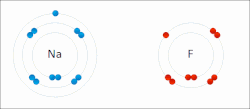Ionic bond
An ionic bond is a chemical bond between a non-metal and a metal ion in a giant ionic crystal lattice. This occurs when charged atoms (ions) attract. This happens after a metal atom loses one or more of its electrons to the non-metal atom. The greater the difference in charge between the metal and non-metal ion, the stronger the ionic bond. A maximum of three electrons can be transferred in the process.
A metal atom becomes a positive cation because it loses electron(s). A non-metal atom becomes a negative anion as it gains electron(s). This occurs, for example, when sodium and chlorine join to form common table salt, NaCl. First, sodium atoms (Na) oxidize and lose an electron to form positively charged sodium ions (Na+). Chlorine atoms gain the electrons from the sodium atoms to form negatively charged chloride ions (Cl-). Both ions are now oppositely charged and they are held by strong electrostatic forces of attraction.
Features of compounds with ionic bonding
- Three dimensional ionic structure called a giant ionic crystal lattice structure.[1]
- Ionic compounds are soluble in water as the ions form favorable interactions with water molecules which release sufficient energy to break away from the lattice.
- In a solid state they do not conduct electricity. However, in a liquid state or when dissolved in water, they will conduct electricity well because the ions are free to move and can carry charge.
- They contrast to the characteristics of covalent bonds.
- covalent bonds may be stronger than the attraction between two ions, but in ionic compounds there are attractions in all directions.
- Ionic compounds have high melting/boiling point due to the strong electrostatic forces of attraction, which require a large amount of heat energy to overcome.
Ionic Bond Media
Sodium and fluorine atoms undergoing a redox reaction to form sodium ions and fluoride ions. Sodium loses its outer electron to give it a stable electron configuration, and this electron enters the fluorine atom exothermically. The oppositely charged ions – typically a great many of them – are then attracted to each other to form solid sodium fluoride.
In the rock salt lattice, each sodium ion (purple sphere) has an electrostatic interaction with its eight nearest-neighbour chloride ions (green spheres)
References
- ↑ Curtis, Cliff (2011). Edexcel IGCSE Chemistry Revision Guide. Pearson Education. p. 21. ISBN 9780435046729.
}}

